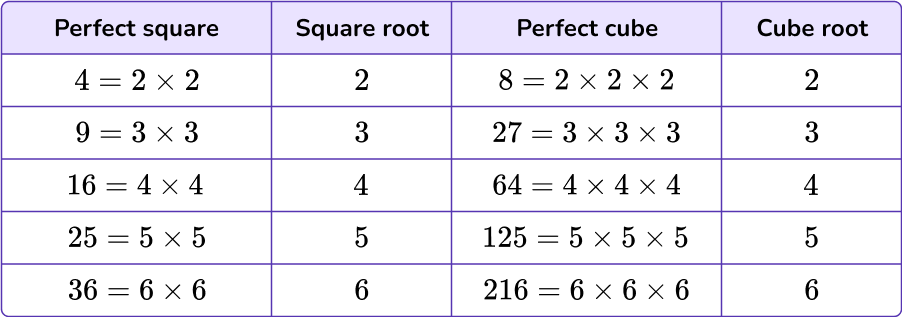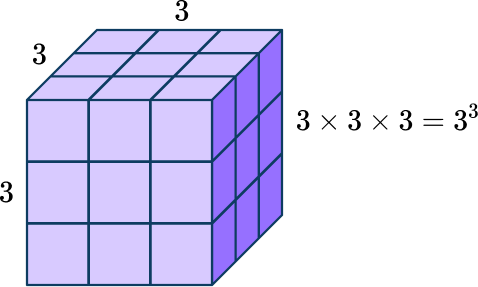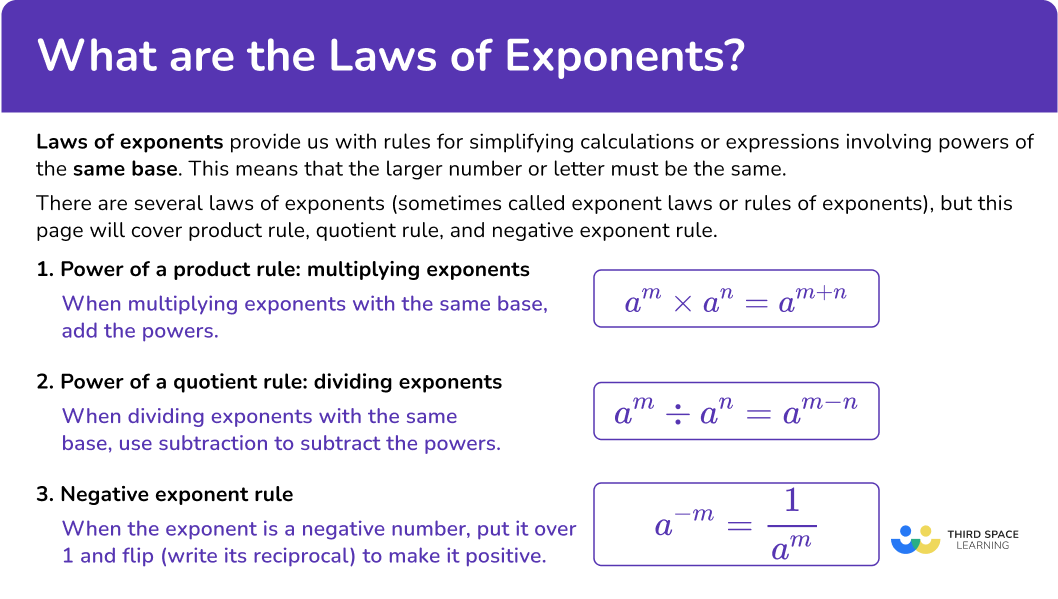High Impact Tutoring Built By Math Experts
Personalized standards-aligned one-on-one math tutoring for schools and districts
In order to access this I need to be confident with:
Exponents Simplifying expressions Order of operationsLaws of exponents
Here you will learn about the laws of exponents, including what the laws of exponents are and how you can use them. You’ll also learn how to write an expression using exponential notation and how to find the cube root of an integer.
Students will first learn about the laws of exponents in 8 th grade and will continue to expand on that knowledge throughout high school.
What are the laws of exponents?
Laws of exponents provide us with rules for simplifying calculations or expressions involving powers of the same base. This means that the larger number or letter must be the same.
For example,
2^{5} \times 2^{3}=2^{8}This is because 2^{5} \times 2^{3} means (2 \times 2 \times 2 \times 2 \times 2) \times (2 \times 2 \times 2). If you count up all the 2 ’s, you can see that there are eight of them or 2^{8}.
x^{10} \div x^{4}=10^{6}This is because x^{10} \div x^{4} means \cfrac{x \times x \times x \times x \times x \times x \times x \times x \times x \times x} {x \times x \times x \times x} , the four x ’s on bottom cancel with four x ’s on the top, leaving you with six x ’s on top or x^{6}.

You cannot use laws of exponents to evaluate calculations when the bases are different.
For example,
2^{5} \times 3^{3} x^{10} \div y^{4}There are several laws of exponents (sometimes called exponent laws or rules of exponents), but this page will cover product rule, quotient rule, and negative exponent rule.
- Power of a product rule: multiplying exponents
When multiplying exponents with the same base, add the powers.
a^{m} \times a^{n}=a^{m+n}Step by step guide: Multiplying exponents
2Power of a quotient rule: dividing exponents.
When dividing exponents with the same base, use subtraction to subtract the powers.
a^{m} \div a^{n}=a^{m-n}Step by step guide: Dividing exponents
3Negative exponent rule
When the exponent is a negative number, put it over 1 and flip (write its reciprocal) to make it positive.
a^{-m}=\cfrac{1}{a^{m}}Step by step guide: Negative exponents
Exponential notation
Exponential notation is a way of representing numbers (constants) and variables (x and y) that have been multiplied by themselves a number of times.
Examples of expressions involving exponential notation:
3^{4} \hspace{1cm} a^{5} \hspace{1cm} 2 x^{7} \hspace{1cm} \cfrac{1}{2}^{2 x} \hspace{1cm} \left(4 y^{2} x^{4}\right)^{7} \hspace{1cm} z^{-\cfrac{5}{2}}Exponential notation is a simple way to express very large numbers or very small numbers.
For example,
Simplify \bf{6 \times 6 \times 6 \times 6}
6 is being multiplied by itself 4 times (repeated multiplication).
Therefore, write this as
6^4You would say this as “6 to the power of 4”
Step by step guide: Exponential notation
![[FREE] Algebra Check for Understanding Quiz (Grade 6 to 8)](https://thirdspacelearning.com/wp-content/uploads/2023/07/Algebra-check-for-understanding-quiz-listing-image-.png)
[FREE] Algebra Check for Understanding Quiz (Grade 6 to 8)
![[FREE] Algebra Check for Understanding Quiz (Grade 6 to 8)](https://thirdspacelearning.com/wp-content/uploads/2023/07/Algebra-check-for-understanding-quiz-listing-image-.png)
Use this quiz to check your grade 6 to 8 students’ understanding of algebra. 10+ questions with answers covering a range of 6th and 8th grade algebra topics to identify areas of strength and support!
DOWNLOAD FREE![[FREE] Algebra Check for Understanding Quiz (Grade 6 to 8)](https://thirdspacelearning.com/wp-content/uploads/2023/07/Algebra-check-for-understanding-quiz-listing-image-.png)
[FREE] Algebra Check for Understanding Quiz (Grade 6 to 8)
![[FREE] Algebra Check for Understanding Quiz (Grade 6 to 8)](https://thirdspacelearning.com/wp-content/uploads/2023/07/Algebra-check-for-understanding-quiz-listing-image-.png)
Use this quiz to check your grade 6 to 8 students’ understanding of algebra. 10+ questions with answers covering a range of 6th and 8th grade algebra topics to identify areas of strength and support!
DOWNLOAD FREECube root
The cube root is the number that is multiplied to itself three times to get a number.
Similarly, square root is a number multiplied to itself two times to get a number.
The table shows some square roots and cube roots.

Roots can be expressed as exponents. For example, \sqrt{4} can be rewritten as (4)^{\frac{1}{2}}.
The same is true for cube root, the \sqrt[3]{8} can be rewritten as (8)^{\frac{1}{3}}. Notice, how the denominator of the exponent is the same as the index of the root.
The way you simplify cube roots is similar to the way you simplify square roots.
(9)^{\frac{1}{2}}=3 because 9 is a perfect square and 3 \times 3 = 9.
(27)^{\frac{1}{3}}=3 because 27 is a perfect cube and 3 \times 3 \times 3=27.
You can visualize a perfect cube as,

What if you have to evaluate a cube root of a number that is not a perfect cube?
For example, \sqrt[3]{16} which is the same as (16)^{\frac{1}{3}}. There is no integer multiplied to itself three times that is equal to 16. So, think about which perfect cube numbers are a factor of 16.
8 is a factor of 16 and a perfect cube, so you can break up 16 to be, \sqrt[3]{8 \times 2}=\sqrt[3]{8} \times \sqrt[3]{2}
\sqrt[3]{8}=2 so, the expression can be rewritten to be 2 \sqrt[3]{2} or 2(2)^{\frac{1}{3}}.
Let’s look at cube roots of algebraic expressions.
\sqrt[3]{x^3} can be rewritten as \left(x^3\right)^{\frac{1}{3}} .
Using laws of exponents, you can multiply the exponents together.
\left(x^3\right)^{\frac{1}{3}}=(x)^{\frac{3}{3}}=x^1=xx^3 is a perfect cube because x \times x \times x is x^3.
Let’s look at another example.
\sqrt[3]{x^9}=\left(x^9\right)^{\frac{1}{3}}=(x)^{\frac{9}{3}}=x^3If you notice, the expression is simplified by the exponent being divided by 3 or multiplied by \frac{1}{3}.
Let’s look at an example when the exponent is not divisible by 3.
\sqrt[3]{x^7}You can rewrite the expression so that part of it has an exponent that is divisible by 3.
\sqrt[3]{x^6 \cdot x^1}=\sqrt[3]{x^6} \cdot \sqrt[3]{x^1}=x^2 \cdot \sqrt[3]{x}A number or variable that is ‘cubed’ is multiplied by itself three times.
Step by step guide: Square root
Step by step guide: Cube root
What are the laws of exponents?

Common Core State Standards
How does this relate to 8 th grade and high school math?
- Grade 8: Expressions and Equations (8.EE.A.1)
Know and apply the properties of integer exponents to generate equivalent numerical expressions. For example, 32 \times 3-5 = 3-3 = \cfrac{1}{33} = \cfrac{1}{27} \, .
- High School – The Real Number System (HSN-RN.A.1)
Explain how the definition of the meaning of rational exponents follows from extending the properties of integer exponents to those values, allowing for a notation for radicals in terms of rational exponents.
For example, we define \cfrac{51}{3} to be the cube root of 5 because we want \left(\cfrac{51}{3}\right)3=5 \left(\cfrac{1}{3}\right)3 to hold, so \left(\cfrac{51}{3}\right)3 must equal 5.
How to use the laws of exponents
There are a lot of ways to use the laws of exponents to solve equations. For more specific step-by-step guides, check out the laws of exponents pages linked in the “What are the laws of exponents?” section above or read through the examples below.
Laws of exponents examples
Example 1: multiplying exponents
Simplify,
4 a^{3} \times 7 a^{2}- Add the exponents.
Add together the exponents 3 and 2.
3+2=52Multiply any coefficients.
Multiply 4 and 7 together.
4 \times 7 =28So,
4 a^{3} \times 7 a^{2}=28 a^{5}This can also be written as
4 a^{3} \times 7 a^{2}=4 \times a \times a \times a \times 7 \times a \times a
Example 2: dividing exponents
Simplify
21 a^{9} \div 7 a^{2}Subtract the exponents.
Subtract the indices 9 and 2.
9 - 2 = 7
Divide any coefficients of the base variables.
Divide the coefficients 21 and 7.
21 \div 7 =3
So,
21 a^{9} \div 7 a^{2}=3a^{7}
Example 3: negative exponents
Simplify and leave your answer in index form.
x^{-7}Put the term over \bf{1}.
When the exponent is negative, put it over 1,
\cfrac{x^{-7}}{1}
Flip the fraction to make the exponent positive.
Flip and change the power from -7 to +7.
\cfrac{1}{x^{7}}
Example 4: negative exponents
Simplify
(2a)^{-3}Notice how the index affects the entire bracket
Put the term over \bf{1}.
Flip the fraction to make the exponent positive.
Flip and change the power from -3 to +3.
\cfrac{1}{(2a)^{3}}
Simplify, if necessary.
Simplify the denominator.
=\cfrac{1}{8a^{3}}
So,
(2 a)^{-3}=\cfrac{1}{8 a^{3}}
Example 5: simplifying an expression involving unknowns and multiplication
Simplify
4 a^3 \times 5 a^2Identify whether the base numbers for each term are the same.
The base number is a and is the same in each term.
4 and 5 are the coefficients of the a terms.
Identify the operation(s) being used.
The terms are being multiplied.
Simplify the expression, using the rules of exponential notation.
4 a^3 is equivalent to 4 \times a \times a \times a.
5 a^2 is equivalent to 5 \times a \times a.
Therefore:
\begin{aligned}4 a^3 & \times 5 a^2=4 \times a \times a \times a \times 5 \times a \times a \\\\
& =4 \times 5 \times a \times a \times a \times a \times a \\\\
& =20 \times a^5 \\\\
& =20 a^5\end{aligned}
Example 6: cube root
Simplify the expression \sqrt[3]{24}.
Identify the number as a perfect cube or factors that are perfect cubes.
24 is not a perfect cube but 8 is a factor of 24 and 8 is a perfect cube.
If necessary, rewrite the expression.
Simplify the expression.
\sqrt[3]{3} cannot take the cube root of 3 without a calculator so leave it.
The simplified answer is 2 \sqrt[3]{3}.
Teaching tips for laws of exponents
- Start with reviewing what exponents are and make sure students are comfortable with working with exponents before introducing the different laws of exponents.
- While worksheets have their place in the classroom, consider using interactive activities that allow students to actively apply the different laws. This can include class discussions with an online platform to increase participation.
- The use of mnemonic devices can help students remember the laws. Allow students to be creative and come up with their own.
Easy mistakes to make
- Using the multiplication and division laws with terms with different bases
The multiplication and division laws of exponents can only be used with terms with the same base. For example, you cannot simplify a^{4} \times b^{3} as the bases are different.
- Not raising all terms inside the parenthesis to the power that is outside the parentheses.
When you simplify, remember to square both the 4 and the a. It is common to forget to square the 4.
For example,
(4a)^{2}
(4 a)^{2}=4 a \times 4 a=4^{2} a^{2}=16 a^{2}
The brackets mean the entire term is squared.
- Confusing laws of exponents with properties of exponents
The two concepts are closely related, however, the properties of exponents refer to the specific behaviors and characteristics of expressions involving exponents. The laws of exponents are general rules that encompass several properties of exponents.
- Confusing positive and negative powers
You can have decimal, fractional, negative or positive integers (exponents).
Practice laws of exponents questions
1. Simplify
4 a^{6} \times 5 a^{-2}




Multiply the coefficients.
4\times5=20
Since the base number is the same in each term, add the exponents.
6+(-2)=4
This means
4 a^{6} \times 5 a^{-2}=20 a^{4}
2. Simplify
-3 a^{4 b} \times 6 a^{7 b}




Multiply the coefficients.
-3\times6=-18
Since the base number is the same in each term, add the exponents.
4b+7b=11b
This means
-3 a^{4 b} \times 6 a^{7 b}=-18 a^{11 b}
3. Simplify
20 b^{10} \div 4 b^{5}




Divide the coefficients.
20\div4=5
Since the base number is the same in each term, subtract the exponents.
10-5=5
This means
20 b^{10} \div 4 b^{5}=5 b^{5}
4. Simplify
(5 x)^{-3}




The negative index number indicates to find the reciprocal of (5x)^{-3}
Since
(5x)^{-3}=5x\times5x\times5x=125x^{3},
This means,
(5 x)^{-3}=\cfrac{1}{125 x^{3}}
5. Simplify 2 c \times 2 c \times 2 c.




Multiply 2c by itself 3 times, which can be written as (2c)^{3}.
6. Find \sqrt[3]{343}.




343 is a perfect cube because, 7 \times 7 \times 7=343
therefore, \sqrt[3]{343}=7
Laws of exponents FAQs
The laws of exponents are defined for positive real numbers and certain cases involving zero. However, expressions involving zero in the denominator or negative bases with non-integer exponents, could lead to undefined results.
If a base is raised to a power and the whole term is raised to another power, the two powers are multiplied and the base stays the same. For example, \left(x^m\right)^n=x^{m \times n}=x^{m n}.
The zero exponent rule states that any nonzero number raised to the zero power is equal to 1. For example, y^0=1 (where y is not equal to 0 ).
The fractional exponent rule states that when there is a fractional exponent, it will result in a radical (square root). For example, a^{\frac{m}{n}}=(\sqrt[n]{a})^m.
Here, \sqrt[n]{a} represents the n -th root of a.
The next lessons are
- Math formulas
- Scientific notation
- Quadratic graphs
- Factoring
- Radicals
- Exponent rules
- Anything to the power of 0
- Distributing exponents
Still stuck?
At Third Space Learning, we specialize in helping teachers and school leaders to provide personalized math support for more of their students through high-quality, online one-on-one math tutoring delivered by subject experts.
Each week, our tutors support thousands of students who are at risk of not meeting their grade-level expectations, and help accelerate their progress and boost their confidence.

Find out how we can help your students achieve success with our math tutoring programs.
[FREE] Common Core Practice Tests (3rd to 8th Grade)
Prepare for math tests in your state with these 3rd Grade to 8th Grade practice assessments for Common Core and state equivalents.
Get your 6 multiple choice practice tests with detailed answers to support test prep, created by US math teachers for US math teachers!